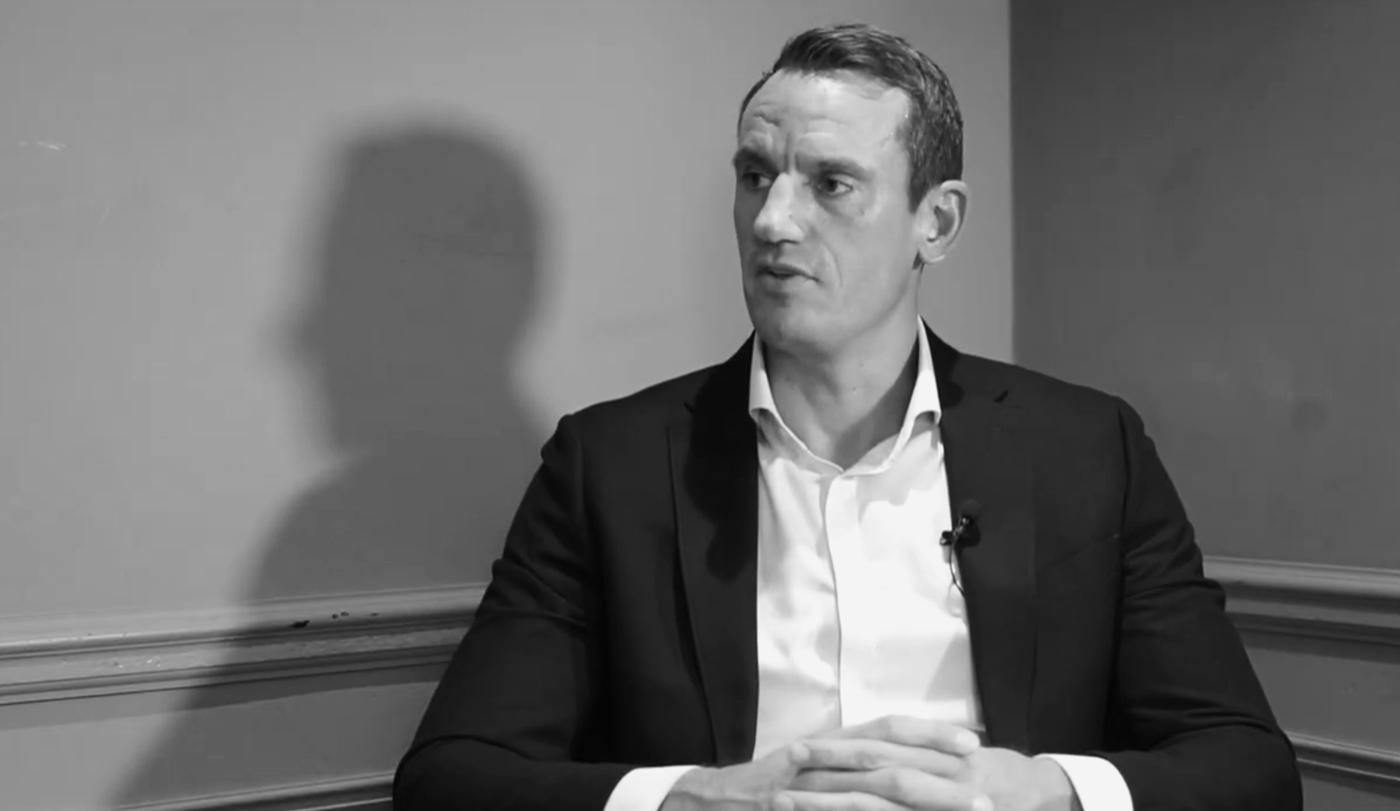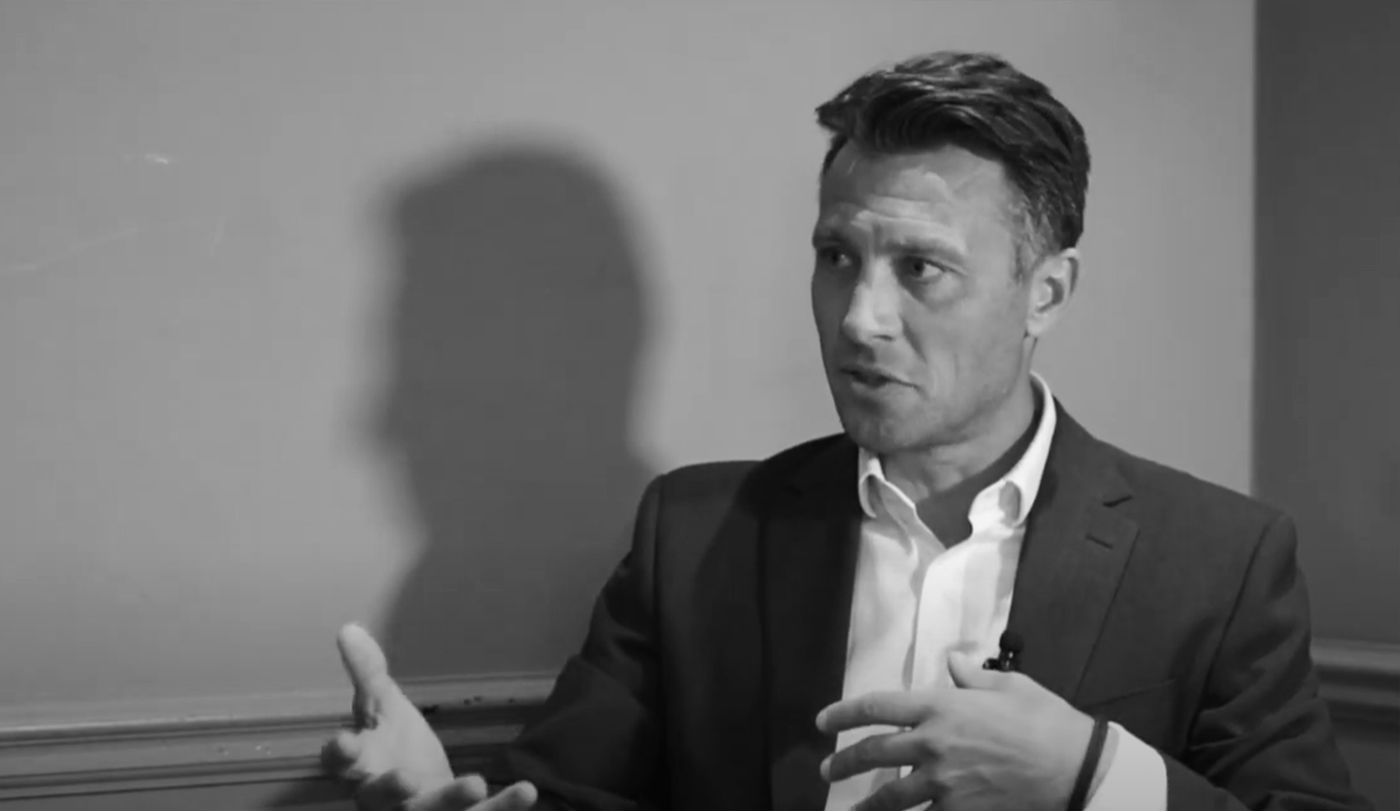On the attractions of absolute return, identifying a manager’s edge and steering clear of baby rhinos
In our regular video series, we interview the wealth sector’s key decision-makers to discover how they think about life, both within the world of investment and beyond it; what brought them into the business and what keeps them here; and what makes them and their companies tick
Some negative experiences of absolute return in the past among wealth managers and advisers have combined with a low level of understanding of the sector more generally to see private investors missing out on returns and diversification benefits, believes Steve Brann, CIO at Apollo Multi Asset Management.
Talking with Wealthwise editorial director Julian Marr in the above video, he says: “When I set up Apollo in 2008, I looked over the pond to America – to David Svensen at Yale and the endowment model – and how successful they had been from the early 1990s at increasing their exposure to absolute return and a wider set of assets.
“Whereas, unfortunately, the UK industry has been a bit tainted by the experience of the ‘GARS’ global absolute return strategies – and, actually, the education process in absolute return isn’t strong enough. People talk about ‘absolute return’ – but what do they actually mean by that? There are many subsets to absolute return, whereas people often think it is just one thing. It’s not – there are probably 10 different subsets.”
People talk about ‘absolute return’ – but what do they actually mean by that? There are many subsets to absolute return, whereas people often think it is just one thing.”
Brann is nevertheless optimistic about the future prospects for absolute return investing, noting: “We have seen a new wave of investment in the US again into the fund of hedge fund industry. And obviously our equivalent in Europe, under the Ucits guidelines, means we can replicate many of those strategies – but with less risk, because there is a better regulatory framework around it and you have daily liquidity, which is much more appropriate for retail investors. I believe the tide is turning and we are starting to see more investors looking at the sector.”
Time-honoured tradition
The conversation also takes in the importance of identifying a fund manager’s edge – and one that is consistently delivered – as well as the dangers of standing in front of even the smallest rhinoceros at feeding time. Also, Brann’s book on absolute return investing has just been published and, in time-honoured chat-show tradition, we are happy to help him to plug it. So – what led him to write Absolute Vision? “Really, the book is trying to break down the whole of absolute return,” he replies. “So it goes through an education piece – you know, What are long-short strategies? What are event-driven strategies? – just trying to educate people throughout all the subsectors.
“So we go through the process – through the kind of questions we ask and how we select managers to try and give people that edge themselves. If they want to go and do that themselves – these are the type of questions and this is what you need to understand when you are going to invest in all of these different managers. So it is a journey through all of the different subsectors, the risk management and how you piece together a portfolio.”
For more from Apollo, read the first instalment of Absolute Insight here
For Brann, the “greatest learning” readers could take from his book is that diversification in absolute return is key. “In equities, if you over-diversify, you eventually come back to index – so there is no point holding 20 different equity funds, because you might as well go and buy a passive ETF!” he says.
“In absolute return, it is completely the opposite – because they all have idiosyncratic risk, you want to try and build a portfolio with as little correlation as possible. So we spend all of our time, when we are building the portfolio, clearly picking the best managers with their niches and their edges – but we are also making sure there isn’t any correlation.
“As a result, some people will probably think we have too wide a portfolio. We have 20 names – and that is a lot of funds – but you don’t want to take the single risk. You don’t want to have the GARS of old where the team leaves or maybe they just make some bad calls for a period of time. When you have a large portfolio, you can afford 25% of it to be underperforming, if the other 75% is doing as it should. So the reason for writing the book was really to try and encourage people to look at absolute return with new eyes and to understand it a bit better.”
A full transcript of this episode can be found after this box while you can view the whole video by clicking on the picture above. To jump to a specific question, just click on the relevant timecode:
00.00: What excites you about the current investment outlook? What worries you?
01.34: What do you most look for in an individual investment?
02.32: To what degree should professional investors be thinking about absolute return strategies?
04:27: Just how tricky did you find launching an absolute return focused business in 2008?
05.40: What drives your approach to client communications? How do you bring clients along for the whole investment ‘journey’?
07.19: So what inspired you to write a book on absolute returns?
09.45: What was your path into investment – and, if you hadn’t taken it, what do you think you would be doing now?
11.02: What was the biggest investment mistake you are prepared to admit to – and what did you learn from it?
13.07: Outside of work, what is the strangest thing you have ever seen or done?
14.03: What advice would you give your younger self if you were starting again?
15:00: What are your best and worst-case scenarios for the future of wealth in the UK?
Transcript of ‘Choice Words’ Episode 8:
Steve Brann, with Julian Marr
JM: Well, hello and welcome to another in our series of ‘Choice Words’ videos where we get to meet key decision-makers from the world of fund selection and fund research and find out what makes them tick. I am Julian Marr, editorial director of Wealthwise Media, and today I am delighted to be talking to Steve Brann, CIO and a founder partner at Apollo Multi Asset Management. Hello Steve.
SB: Hello, Julian.
JM: Let’s jump straight into my first question – what excites you about the current investment outlook? What worries you?
SB: Well, clearly, we are going into a new paradigm at the moment with Donald Trump. The last couple of years have been dictated by the ‘Mag Seven’ and passive investing but I think we are now going through – or hopefully going through – a new era of dispersion, where we might see other markets start to dominate.
In that regard, we had quite a significant event at the beginning of the year with DeepSeek so I think some of the valuations of US equities are starting to be questioned and the opportunity set is elsewhere. So I think it is a time that active management comes to the fore – and, as I say, dispersion works for those active managers. We are particularly keen on absolute return investing as well so, the more dispersion there is in the market, the better it is for absolute return managers.
I guess the things that slightly worry me are still the rising political tensions we have around the world – I mean, I can’t really remember a time in my career when we have had so many issues, but the market at the same time has been incredibly complacent. I think people have got used almost to ignoring geopolitical risk – and that can be foolish. We haven’t really had anything that has significantly kicked off since the Gulf War but, since then, that level of complacency with the amount of geopolitical risk we have is a bit concerning for me.
Consistency and edge
JM: What do you most look for in an individual investment?
SB: I guess it is the same for long-only managers and absolute return managers in that we are always looking for an edge. I mean, that is the most important thing any fund manager can deliver – an edge. What do they do better and different to other managers in the market? And then it is the consistency – once you have worked out what their edge is, you have to make sure they can deliver that on a consistent basis.
We like to give our managers plenty of time to be able to demonstrate those returns. The industry has become really short-term – and I think that is a mistake – and investors and financial advisers are also becoming a bit too short-term, in my view. So we are looking for that repeatable process and, while we won’t expect managers to perform in every environment, we do want them to deliver the edge they are good at. So it is consistency and edge over the competition – that is what we are looking for.
Turning tide
JM: At this point, I usually ask to what degree people should be thinking beyond so-called ‘traditional’ investments and towards what – but, given what you have already said, let’s take your answer to the first part as a given and ask to what degree should professional investors be thinking about absolute return strategies?
SB: Yes, it is my sort of ‘specialist subject’ – as you know, I have just written a book on the subject – but I do think it is an area UK retail investors have really missed out on. When I set up Apollo in 2008, I looked over the pond to America and to David Svensen at Yale and the endowment model – and how successful they had been from the early 1990s at increasing their exposure to absolute return and a wider set of assets.
Whereas, unfortunately, the UK industry has I think been a little bit tainted by the experience of the ‘GARS’ global absolute return strategies – and, actually, the education process in absolute return isn’t strong enough. People talk about ‘absolute return’ – but what do they actually mean by that? You know, there are many subsets to absolute return, whereas I think people think it is just one thing. It’s not – there are probably 10 different subsets to absolute return.
So I am trying to help educate people in trying to understand those subsets – and a common mistake we have seen in the past is people try to pick one single fund as their exposure. Over years of developing it, though, we feel that a portfolio approach is more appropriate across the different strategies in absolute return.
I am optimistic – we have seen quite a new wave of investment in the US again into the fund of hedge fund industry. And obviously our equivalent in Europe, under the Ucits guidelines, means we can replicate many of those strategies – but with less risk, because there is a better regulatory framework around it and you have daily liquidity, which is much more appropriate for retail investors. So I am really optimistic. I believe the tide is turning and we are starting to see more investors looking at an absolute return.
Sink or swim
JM: Just how tricky did you find launching an absolute return focused business in 2008?
SB: Actually, in terms of setting up a business, that was the toughest part. It is quite a funny story because we actually got our FSA regulation – it was the FSA back in those days – on the day Lehman Brothers went bust. So it couldn’t have got much worse and we were either going to sink or swim. Obviously, whatever it is now – 17 years later – we are swimming.
But, yes, it is difficult in those environments – but we were lucky. I was at Miton before Apollo and a number of investors followed us, which I thought it was particularly brave – you know, you were never going to get sacked if you were invested in a Fidelity or a BlackRock fund back in those days. But, going for Apollo, when it had, you know, only tens of millions of money under management, it was quite a brave decision for people to invest.
Still, that was actually quite a positive point for us to launch as it meant that, in that difficult wave everyone went through in 2008, we were able to outperform because of the exposure we had to absolute return. So that got us off on a really good footing, from a performance point of view. As for a business point of view – yes, it was hard work.
Acquired taste
JM: What drives your approach to client communications? How do you bring clients along for the whole investment ‘journey’?
SB: I guess we have a slightly different business model to most at Apollo. We are very much into a partnership relationship – so we have a small number of client relationships, rather than a scatter-gun approach. And it is a slightly acquired taste still – absolute return. When you come to Apollo, you know you are going to have potentially 30% – maybe even 40% – in absolute return so, if you don’t understand it and you are not willing, you are not going to come to Apollo!
So we have always been strong on that partnership and education. We sit down with our clients to make sure they fully understand, you know, What is absolute return? Why is it in their portfolios? And in recent years, obviously, there has been a great benefit because, as we saw in 2022, for example, you had equities and bonds correlating negatively.
And actually, in many ways, I think the industry has to look at itself – because why was it that, in 2022, the average cautious portfolio was down more than an adventurous portfolio? We are doing something wrong if that is kind of the risk-grading. And so that has opened the door for us to say, Actually, if you had had less in bonds at that particular time and more in absolute return, you would have performed that much better.
And that is why I am so optimistic about the absolute return sector. The last couple of years has been quite difficult – especially in that cautious area – so I think people are becoming more attracted to it. Still, we just want the right clients who understand why we do what we do – and who have bought into that whole process.
‘Absolute Vision’
JM: So what inspired you to write a book on absolute returns?
SB: The book is called Absolute Vision and, really, it is trying to break down the whole of absolute return. So it goes through an education piece – you know, What are long-short strategies? What are event-driven strategies? – just trying to educate people throughout all the subsectors. Because when I speak to a lot of people, they just say ‘absolute return’ and think it is one thing – and it is clearly not.
So we go through the process – through the kind of questions we ask and how we select managers to try and give people that edge themselves. If they want to go and do that themselves – these are the type of questions and this is what you need to understand when you are going to invest in all of these different managers. So it is a journey through all of the different subsectors, through the risk management and through how you piece together a portfolio.
The greatest learning people could take from the book is that diversification in absolute return is the absolute key. In equities, if you over-diversify, you eventually come back to index – so there is no point holding 20 different equity funds, because you might as well go and buy a passive ETF!
In absolute return, it is completely the opposite – because they all have idiosyncratic risk, you want to try and build a portfolio with as little correlation as possible. So we spend all of our time, when we are building the portfolio, clearly picking the best managers with their niches and their edges – but we are also making sure there isn’t any correlation.
As a result, people may think we probably have too wide a portfolio. We have 20 names – that is a lot of funds – but you don’t want to take the single risk. You don’t want to have the GARS of old where the team leaves or maybe they just make some bad calls for a period of time. When you have a large portfolio, you can afford 25% of it to be underperforming, if the other 75% is doing as it should.
So the reason for writing the book was really to try and encourage people to look at absolute return with new eyes and to understand it a bit better – because I don’t think there is enough education in the CFA and in other exams. In fact, if you google ‘absolute return course’, you will struggle to find one – and so somebody needs to be out there trying to promote the subject.
Take a ‘Chance’
JM: What was your path into investment – and, if you hadn’t taken it, what do you think you would be doing now?
SB: I think I was probably always destined to do something in finance. My father was the managing director of Chemical Bank’s FX division so, as a kid, I learned how to trade FX. The firm had lots of graduate games – for example, they had the equivalent of Monopoly. It taught you in a Monopoly-style – so you’d turn over a card and it would be a rate decision instead of ‘Chance’ or whatever.
So I learned macroeconomics and trading while still at school and I thought I was going to be an FX trader – but then I experienced a kind of ‘reverse nepotism’. I went through a number of interviews where, when people said, Is your father Alan Brann at Chemical Bank? I’d say, Yes – and they’d go, You can’t have a job here then!
So I had to slightly redirect myself – and that is what took me into fund management. As I had the experience of macroeconomics, it lent itself to moving into another field. So I didn’t go to university but I was very lucky – I got a job very early on at Lucas Industries, which was one of the top 10 pension funds at the time, and so I started running money in my teens, in fact.
Meeting A. Nadir
JM: What was the biggest investment mistake you are prepared to admit to – and what did you learn from it?
SB: I included this one in my book, actually! Very early on, I was given the role of running the cash management at Lucas Industries. We had fairly substantial cash – up to £200m – so we used to invest it in short-term commercial paper. And we had a policy to only invest in A-grade paper. I went on holiday – so, indirectly, I was involved – but my boss saw there was some Polly Peck paper on offer for three weeks at triple-B.
The rates were pretty phenomenal so he took the decision to invest in Polly Peck paper – and we put in £25m. I came home from holiday and kind of questioned, What are we doing with triple-B paper? Unfortunately, in the three weeks we were holding the paper, Polly Peck went under. So that was a massive shock – but one of my memories was actually having to physically serve the writ to [its chief executive] Asil Nadir. So I had to go and knock on the doors of Polly Peck in Berkeley Square and wait for four hours until Asil Nadir appeared …
JM: So he was actually still in the country at this point!
SB: Yes. But I had to wait and physically serve the writ to him, which was quite an intimidating four-hour wait. I think I was only 19 or 20 at the time and, you know, just to be in a room with Asil Nadir was quite intimidating – and, as you can imagine, he wasn’t best pleased either!
So, yes, when you have something like that early on in your career, you realise: one, if there are rules like you are supposed to only invest in AAA paper, never break those rules; but also, two, just how quickly an investment – especially in credit – can unravel. You know, equity tends to be more of a slow burn – with credit, it is bust or not. You know, you either pay the money back or you don’t. So it was a harsh lesson but, you know, one I am kind of thankful I have had because you learn a lot when things like that happen.

Solid advice
JM: Outside of work, what is the strangest thing you have ever seen or done?
SB: I guess one of the strangest things – or one of the things that sticks in my mind the most – was when I went on a safari. We were just off Lake Kariba and there was a boma for orphaned rhinos, where we had the privilege of taking these three baby rhinos to their feeding grounds every morning. And it was just surreal – I mean, the chance of many people seeing rhinos these days is quite limited, but to take three of them for a walk …
But I did make a little bit of a mistake as I got bit overconfident on day three. They had advised me, Never stand in front of them! And there was this little baby rhino called Mbizi – it was like a giant tortoise, really – but the thing decided to charge me and did I know about it! So that is probably the answer.
JM: What advice would you give your younger self if you were starting again?
SB: It is some advice somebody gave me, actually, that I would just repeat to myself. This was that, especially in finance, you need to somehow smooth the journey – because it is a rocky ride. You can have super-highs and super-lows, especially when you work in the business – you know, I worked in the banks quite a lot on proprietary trading and you had some good days where you thought you were going to make million-pound bonuses and then, the next week, you thought you were going to be sacked!
And one trader took me aside very early on in my career and just said, Look, Steve, if you are going to survive in this industry, you have got to take away the highs and the lows and try and smooth the journey. And that advice has always stuck with me. It was given to me very early on and I would throw that out to anybody else in finance – you know, you are never always a hero, and it is not always going to be the day you are going to get sacked if you make a bad decision.
Return and journey over cost
JM: What are your best and worst-case scenarios for the future of UK wealth?
SB: One of the disappointments I have seen in the last few years is the ‘race to the bottom’ in cost – that is really something I think is quite sad. Obviously, because we use a lot of absolute return, we do have a bias towards active management. We use passive in the right instances but we have a genuine belief that there is a value in really good fund managers – especially in absolute return, because that is the truest sense of alpha. So it is worth paying for.
And I have just been disappointed that the industry is becoming so cost-oriented rather than return-oriented. You know, one of the best managers I invested in was Martin Taylor at Nevsky, back in the day. He was a ‘two and 20’ hedge fund manager but he had such a great track record, smoothed out the returns and I would pay two and 20 for that guy all day long– and yet we are kind of scrambling around for 20 basis points of cost in some areas of the market.
The other thing that has disappointed me is the amount of risk grading-led models we now have. And we have faced the same problems where we were told by a number of the risk-grading companies that we couldn’t have absolute return in a cautious portfolio, and we had to have certain allocations to fixed interest – and we’re sitting there saying, Look, we have been around the block. At some point, inflation is coming back and the bond market is going to have a torrid time and you are putting cautious investors into an asset class where they are going to get smashed.
And we have seen gilts down 30% over that period – and some of those cautious clients are never going to build that back up – so I think the outsourcing of risk-grading has been to the detriment of investor returns. We need to think more carefully about these things – hence why we believe that absolute return will help towards having a more diverse portfolio.
Because we are getting closer to 60/40 again than we have almost ever been. Property used to be quite a good diversifier – and then we had the kind of mismatch of daily liquidity. And so really you can only go into an equity version of property – and then, at the wrong time, that becomes an equity. So I have just been a bit disappointed by where the industry has gone in the last couple of years.
I guess, trying to be more optimistic about it, let’s hope that tide is turning – because more and more people, certainly the banks, are talking about active management again. And that is the real way we can get to some decent returns – you know, be cognisant of costs but, actually, the return and the journey is more important than the cost profile, in my view.
JM: Absolutely. Steve Brann, thank you so much for coming onto Choice Words and talking to us today. And thank you all very much for watching.
Please do look out for further Choice Words episodes as they are published









